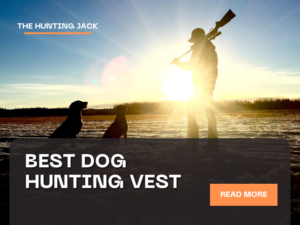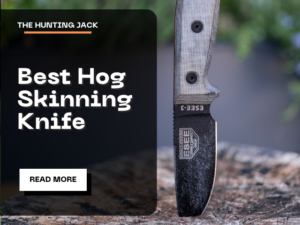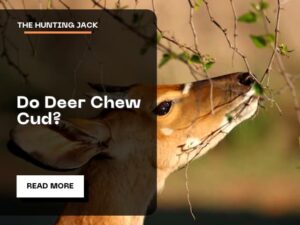White-tailed deer are members of a family of herbivore animals called ruminants, which means they have four stomach chambers to digest their food. These species get their nutrients from plant matter through a process known as rumination.
Have you seen a deer tucking into a huge pile of leaves when deer hunting and wondered why? Hang around, and I’ll tell you.
Table of Contents
ToggleWhat Exactly are Ruminants?
We know that herbivores are plant-eaters. Of these, the majority eat green and leafy plants containing cellulose, a molecule made up of thousands of oxygen, hydrogen, and carbon atoms. Cellulose is the main ingredient in plant cell walls, allowing them to stay firm and erect.
Human stomachs can’t digest cellulose, but as fiber, it’s an integral part of our diets. Ruminants, including cattle, sheep, giraffes, and deer, have stomachs that can digest cellulose. It’s not a simple process though. That’s why ruminant animals were created with a specialized and complex digestive system.
What is Chewing Cud?
When ruminants eat, they swallow large amounts of leafy cellulose without chewing; then regurgitate it. When it’s back in their mouths, they start to chew. We recognize this partly-digested food as cud.
Cud isn’t a small amount of food. In fact, the size of this regurgitated portion starts around the size of a small orange. It fits into the animal’s mouth well enough to chew without spewing. Ruminants will regurgitate and chew the cud several times, breaking it down into smaller sizes until it’s all suitable to digest.
So, Do Deer Chew Cud?
Deer are ruminants, so by definition, they chew cud. Whitetail deer spend their feeding time dining on twigs, buds, grass, and leafy plants, which are full of cellulose. As ruminants, natural adaptation, symbiosis, and complex digestive systems mean deer digest their high-cellulose diet in massive amounts.
Deer, goats, cattle, sheep, and other ruminants have a part of their stomachs known as the rumen, which is why we call these herbivores ruminants. The rumen is only one part of a four-chambered stomach and controls the early digestive part of their eating.
Different deer spend more time chewing cud. The whitetail deer goes through the process around 40 times before complete digestion, while mule deer, for example, chew cud up to 60 times.
You should stay on your toes when hunting, especially if a deer is busy feeding. Heightened senses while feeding at dusk or dawn means hunters should plan any reconnaissance well. If you are new to the sport, it helps to know about a deer’s specialized digestive system, so pay heed to the following:
How Deer Survive When Food is Short
All ruminants roam, feeding on different greenery. Through time, like all living things, they have adapted, meaning they can live in territories where food sources are scarce and the competition is high.
Deer survive by initially consuming their food rapidly, hardly chewing at all before their first swallow. They completely fill the rumen, or upper portion of their stomach, and then go about digestion by chewing cud multiple times.
Thanks to its unique digestive system, a deer fills itself with the food it needs to survive and then can take its time digesting it.
A Deer’s Digestive System
So we’ve already established that a deer and every other ruminant has a four-chambered stomach. As humans, we all have a single chamber to our stomachs, meaning that we consume and digest our food in a single process.
Peristalsis is the primary function of a deer’s digestive system. It occurs when several muscle contractions work in waves to move food through the digestive tract. This starts in the esophagus, where swallowed food transfers to the stomach.
In humans, these muscular wave-like contractions cause us to vomit, while a deer’s digestive system actually depends on them.
The deer’s digestive process involves the following four stomach chambers:-
The rumen
Once deers eat and swallow their food, the esophagus sends it to the first chamber of their four-chambered stomachs, called the rumen. The rumen is why deers can gulp down their food without chewing, as it stores the food until it is full.
Once full, the rumen will begin the peristaltic movements, sending small portions of the swallowed food back to the deer’s mouth. Once this happens, deer chew their cud before sending the partially-digested food into the stomach’s second chamber, the reticulum.
The reticulum
The reticulum is the second portion of the deer digestive system. As often deer chew cud and swallow, the busier the reticulum becomes. It breaks down more and more cellulose into smaller particles for digestion. The reticulum has micro-organisms that assist in the breaking down process by producing cellulase enzymes.
Once the reticulum’s micro-organisms start breaking down the cellulose, the deer’s stomach starts producing methane. This is, in turn, sporadically burped out through the esophagus. This micro-organism movement is better known as fermentation. The reticulum causes further regurgitation and extends the cud-chewing process continues.
A deer chewing cud will only receive that cud from either the rumen or reticulum. In the case of the reticulum cud, it’ll contain micro-organisms, with most of the food’s nutrients coming from the breaking down of these.
The omasum
The micro-organism count is high enough to leave the reticulum with plenty to assist further food digestion. Even though deer chew cud containing the reticulum’s organisms, microbes in the second portion of the stomach never deplete.
When deer swallow regurgitated food from the second chamber, it gets sent straight to the third chamber. We call the third section of the four chambers the omasum. Its function is to absorb water from the cud and send it on to the fourth chamber, the true stomach, called the abomasum.
The abomasum
Much like a human stomach, gastric juices like hydrochloric acid fill the abomasum. These gastric juices break down the remaining cud. The remaining food passes as fully-digested cud into the twenty-eight-foot-long deer intestines. Any nutrients get absorbed into the deer’s body, and the rest passes as waste droppings.
How Cud Gets Back to a Deer’s Mouth
When the rumen fills, it creates a vacuum in the passage. The pressure this creates causes a suction from the rumen back into the mouth of the deer. The deer catches food between its top palate and tongue, releasing water and triggering regurgitation. After that, the deer will start chewing again.
FAQs
How long do deers chew their cud?
Digesting food in a deer’s second stomach, the reticulum, takes approximately 16 hours. All deer chew their cud, but the number of times they do it ranges between different species of deer. There is no specific number of times for deer in general.
Why do deer chew their cud lying down?
The deer fills its rumen, or upper digestive section, and heads to its bedding area, where it will start chewing its cud. When you chew anything as long as a deer needs to, it’s quite an exhaustive process. Lying down gives a deer chance to relax while completing the digestive process.
Do deer normally drink water or eat food first?
Deer, especially mature deer, will likely drink water before they begin feeding. Drinking water after eating is not conducive to the cud-chewing digestive process. A deer also replenishes its liquid content during regurgitation when the cud passes water to the mouth on arriving from the rumen.
Does a horse chew the cud?
Horses are not ruminants as they don’t have four-chambered stomachs. A horse’s esophagus has a one-way peristaltic action, meaning they don’t regurgitate its food. They can’t chew the cud like deer, antelope, cows, sheep, giraffes, and further ruminants do. They also don’t pass gas burp through their esophagus.
In Closing
Like all other ruminants, deer will chew their cud. The first of their chambered stomachs is the one that starts the digestion process. It is responsible for the magical way a deer’s digestive system works.
As humans, we’ll never fully understand how a deer feeds and digests its food or how long it takes to do so. Let’s face it, we have it easy popping into McDonald’s for a Big Mac! We can enjoy our meal, and return to our busy lives in half an hour. Deer, sheep, goats, giraffes, and cattle would have so much time left in their days if they could do the same.
Bookmark my site for more useful information, including how to hunt deer from the ground.



